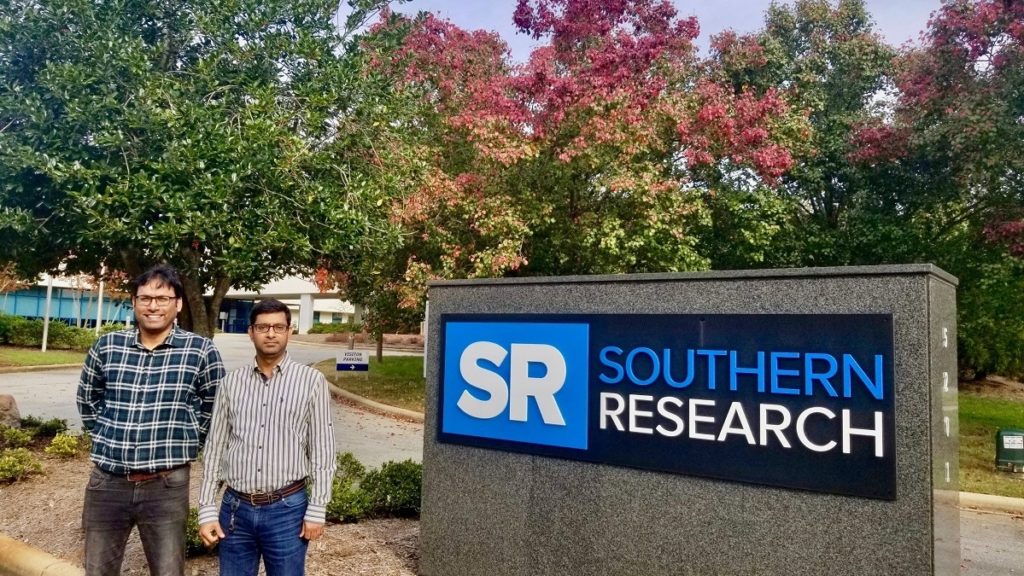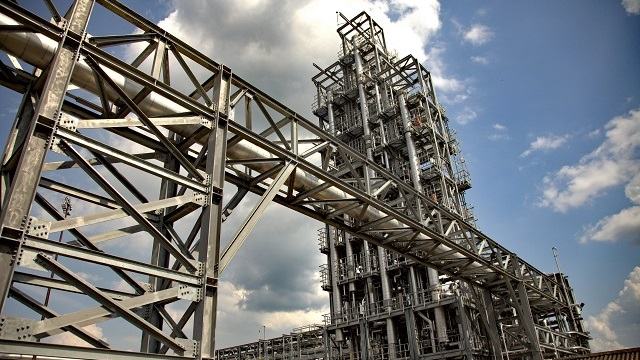Birmingham’s Southern Research receives funding from US DOE

The U.S. Department of Energy (DOE) has selected Southern Research for an award of up to $1.5 million to advance technology for carbon dioxide (CO2) utilization. The DOE award, now being negotiated, will fund scale-up and field testing of a catalytic process for conversion of CO2 and shale-derived ethane to ethylene, a valuable olefin. Olefins serve as building blocks for a sweeping variety of products such as packaging, plastics, textiles, paints and electronics. Industrial demand for olefins such as ethylene and propylene is rising at 4 to 5 percent annually as living standards improve across the world. This diagram shows the process of how carbon dioxide is transformed into light olefins. (Southern Research) Over the last two years on a previously funded DOE study, Southern Research has developed a novel nano-engineered catalyst-driven process for the production of light olefins, such as ethylene, using CO2 from coal-fired flue gas and lower alkanes derived from shale gas feedstock. This lab scale study demonstrated the conversion, selectivity and stability of this new generation catalyst in presence of flue gas impurities and low concentrations of CO2. The results of the lab scale study led to this new award, which consists of constructing and operating a field scale unit. This project will produce and test a larger amount of catalyst and validate both the process reliability and the ability to produce ethylene at the next engineering scale. “Ethylene and propylene are the highest-volume petrochemicals in use today. Current production methods are capital- and energy-intensive as well as large greenhouse gas emitters,” said Corey Tyree, Ph.D., senior director of Energy and Environment at Southern Research. “By combining CO2 with shale gas, which is readily available in the U.S., our new process promises to have meaningful economic and environmental impact,” he said. The project’s long-term goal is a commercially viable and environmentally friendly technology for producing light olefins via CO2 utilization. Environmental benefits Production techniques for ethylene, which is manufactured in amounts greater than any other chemical, typically use naphtha or ethane as raw materials, and require a large amount of energy to crack apart molecules. Principal investigator Amit Goyal, Ph.D., director, Sustainable Chemistry and Catalysis, said Southern Research’s innovative process concept can use CO2 directly (or captured) from coal-fired power plants, or derived from any source, to produce light olefins. The new technique can yield significant environmental benefits by becoming a net consumer of CO2, he added. “Ethylene alone accounts for 1 percent of the world’s energy consumption and 180 to 200 million tons of CO2 emission,” Goyal said. “Due to the large magnitude of ethylene production, any reduction on the energy requirement will be highly impactful.” The approach would reduce carbon dioxide emissions from coal-fired plants, the top emitters of the colorless, odorless gas in the U.S power sector. In 2015, coal-based power plants in the United States emitted nearly 1.4 billion metric tons of CO2. “Coal is abundant and cheap, making it a vital energy source,” said Jadid Samad, Ph.D., advanced chemical engineer and co-principal investigator for Southern Research. “A smart solution to the issue of emissions from coal-fired power plants lies in the prospect of using CO2 as feedstock to produce valuable chemicals.” Converting CO2 Samad said Southern Research’s approach on the project directly supports the Carbon Use and Reuse research and development portfolio being assembled by DOE’s Office of Fossil Energy. The portfolio is developing and testing novel approaches that convert captured CO2 from coal-fired power plants into usable products. The funding from the Office of Fossil Energy for Southern Research’s project totals $1,499,442. The office announced Oct. 31 that it has committed a total of $18.7 million to funding projects to support its Carbon Use and Reuse R&D portfolio. Southern Research’s partners include 8 Rivers Capital LLC, a company developing and commercializing sustainable infrastructure technologies, which will provide support on the project’s techno-economic analysis. The National Carbon Capture Center, a DOE site for testing innovative technologies, will provide the field site and flue gas feed generated at a utility plant for the project. The center is operated by Southern Company and based in Wilsonville. In addition, a petrochemical consultant will provide guidance on catalyst development, as well as scale-up and commercialization aspects of the project. This story originally appeared on Southern Research’s website. Republished with permission from the Associated Press.
Wilsonville research facility marks technology testing milestone

The National Carbon Capture Center, a U.S. Department of Energy (DOE)-sponsored research facility at Alabama Power’s Plant Gaston in Wilsonville, recently surpassed 100,000 hours of technology testing. The milestone marks significant work by the internationally known test facility, which is managed and operated by Southern Company. The center works to accelerate the development of advanced technologies to reduce greenhouse gas emissions from natural-gas and coal power plants. “It has been an honor to collaborate with DOE, its National Energy Technology Laboratory and our partners at the National Carbon Capture Center to evaluate and demonstrate next-generation carbon capture technologies,” said Southern Company Executive Vice President and Chief Operating Officer Kimberly S. Greene. “I also commend our highly skilled employees, whose commitment to building the future of energy through innovation is at the heart of this achievement.” Since its creation by DOE’s Office of Fossil Energy in 2009, the National Carbon Capture Center has worked with third-party technology developers, including more than 30 government, industry, university and research organizations from seven countries. The facility offers a pathway to move novel carbon capture technologies out of the laboratory and demonstrate them in the real-world conditions of a power plant. The National Carbon Capture Center is also active internationally as co-founder and chair of the International Test Center Network, a coalition of facilities focused on accelerating the research, development and deployment of carbon capture, utilization and storage technologies. Under the center’s guidance, testing collaboration and knowledge sharing is ongoing in Australia, Canada, China, the European Union, India, Japan, Korea, the United Arab Emirates and the U.S. While technology development at the National Carbon Capture Center currently focuses on post-combustion carbon capture technologies for coal-fueled power generation, the facility is expanding Its testing of carbon capture technologies for natural gas power plants. Republished with permission from the Alabama NewsCenter.
Daniel Sutter: Bad economics produces poor policy

Do you care about the mileage your car gets? Some economists, and the bureaucrats at the Department of Energy (DoE), don’t think so, and use this belief as a basis to restrict the products available on the market. Research examining different energy-related decisions, like the purchase of high mileage cars and energy saving appliances, and insulating and weatherizing homes, provides support for this belief. But the research is largely bad economics, and based on confusion. Engineers and economists use the term energy efficiency very differently. Engineers consider an appliance or machine energy efficient if it uses less energy to perform a task. Economists say we use energy efficiently when we minimize the cost of energy use plus the cost of saving energy. As an economist I think that our definition is more relevant, but let’s consider why. Would you want to buy a car that gets 60 miles per gallon but cost $200,000, or cost only $20,000 but could go only 30 miles per hour? Would you want to buy a clothes dryer that used little electricity but required 2 days to dry a load of clothes? I suspect not. The engineering focus on energy use to the exclusion of other considerations makes for economic nonsense. Many studies purport to find evidence that Americans consumers and businesses fail to buy more expensive products that use less energy and engineers believe would “pay for themselves” in cost savings. This result has become known as the “energy efficiency paradox.” But it is bad economics. Good economics attempts to understand decisions as consumers or businesses do; there are many reasons why people may not to purchase the product using the least amount of energy. This thinking is affecting our lives. The DoE has been aggressively tightening energy efficiency standards authorized by the Energy Policy and Conservation Act of 1975. The DoE in 2015 was in the process of revising 35 standards for residential and commercial products. Each standard limits Americans’ freedom of choice by only allowing products meeting DOE’s definition of efficiency on the market. Global warming policy also exploits the energy efficiency paradox as a cheap way to meet a large part of the greenhouse gas emissions reductions needed to meet the Clean Power Plan’s targets. The cost of meeting the Clean Power Plan’s emissions reductions will greatly exceed estimates if the energy efficiency paradox is not valid. Economist Walter Williams, who will be visiting Troy and the Johnson Center next spring, has often noted that while a thief will take your money and be off, a politician takes your money and then insists on telling you that you are better off as a result. Similarly, the DoE’s cost-benefit analyses claim that we are better off being prevented from buying the refrigerators, air conditioners, and dryers we would otherwise. Do Americans in fact ignore energy costs? When I was growing up, I helped my Dad insulate our house to save on winter heating costs. Millions of Americans bought fuel efficient cars imported from Japan in response to the Energy Crisis of the 1970s. Record oil prices over the past decade led many people to buy hybrids, while people are driving more in response to this year’s lower prices. The evidence confirms what we know from our own actions. The used car market allows us to see if Americans value energy savings, since higher gas prices should reduce the price of cars which get poor gas mileage. Studies have consistently found that used car prices move as expected. Economists Ted Gayer and Kip Viscusi recently concluded that research on energy efficiency “does not provide strong, credible evidence of persistent consumer irrationality.” The United States was founded on the principle that government exists to serve citizens, which I hope we still believe in. If so, it is illegitimate for politicians and bureaucrats to impose their choices on us simply because they can. Many policy makers now feel free to override Americans’ decisions about energy due to charges of irrationality based on weak evidence and bad economics. Bad economics often leads to poor government policy, and we suffer the consequences. Daniel Sutter is the Charles G. Koch Professor of Economics with the Manuel H. Johnson Center for Political Economy at Troy University and host of Econversations on TrojanVision.


